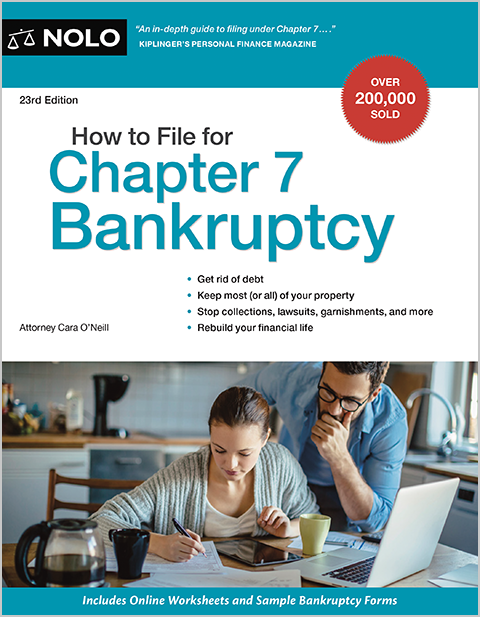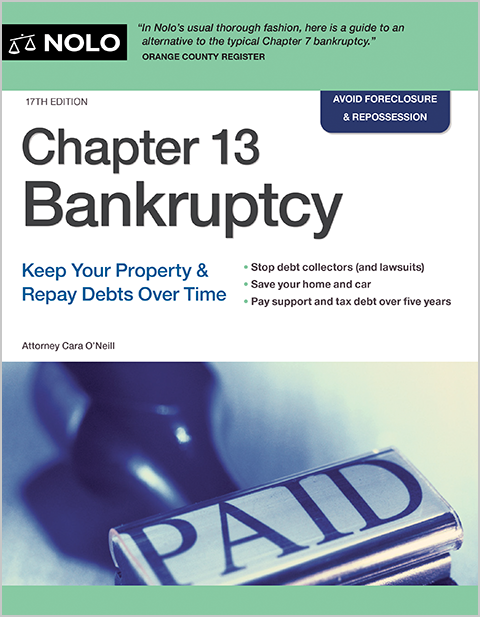Learn whether you meet Chapter 7's income limits or if Chapter 13 is your only option.
People of all income levels can file for bankruptcy. However, Chapter 7 income limits exist, and the amount you earn often determines whether you must file for Chapter 7 or Chapter 13 to wipe out qualifying debt. Even so, you still might be eligible for Chapter 7 bankruptcy because your ability to file a particular chapter depends on a complicated analysis of income and deductible expenses.
- How Do Chapter 7 Income Limits Impact Chapter 7 Bankruptcy Eligibility?
- Can I Qualify for Chapter 7 Bankruptcy With a Substantial Income?
- Which Expenses Will Help Me Qualify for Chapter 7 Bankruptcy?
- Gross Household Income and the Means Test
- Deducting Expenses to Pass the Means Test
- No Income Limits for Chapter 13 Bankruptcy
- Other Considerations When Choosing a Bankruptcy Chapter
- Need More Bankruptcy Help?
How Do Chapter 7 Income Limits Impact Chapter 7 Bankruptcy Eligibility?
Most people want to file Chapter 7 because it wipes out most unsecured debt, such as credit card accounts, utility balances, and medical bills, without requiring monthly payments to creditors for three to five years. However, not everyone qualifies for a Chapter 7 discharge, the order that wipes out qualifying debt.
To determine whether you qualify, you must pass the two-step means test. The means test measures your ability to pay some amount toward your debt through a Chapter 13 plan. Although it would be challenging to pass the first part while making considerable money, it can happen if you have a large family. Otherwise, you'll have a better chance of passing the second part of the means test.
Can I Qualify for Chapter 7 Bankruptcy With a Substantial Income?
You'll likely fail the first part of the Chapter 7 means test if you make a lot of money because it compares your family's gross income to your state's median income for the same household size. You won't get a break if you have a small to moderate family size.
However, if you fail the first part, you'll deduct expenses in the second part, and if your expenses are high enough, you'll pass. But you shouldn't assume you'll pass the second part with flying colors if you struggle to pay your monthly expenses. Bankruptcy law doesn't support lavish lifestyles, so many monthly expenses are limited to reflect regional and national averages.
Which Expenses Will Help Me Qualify for Chapter 7 Bankruptcy?
Typically, people with high incomes who qualify for Chapter 7 bankruptcy have significant balances of "priority" debt, which, in many cases, isn't dischargeable in bankruptcy. The most common are tax debts and domestic support arrearages. Other obligations that help high earners pass the means test include mortgages, car loans, and late payments of the same. Tuition, mandatory payroll deductions like union dues, and court-ordered payments can also help.
Also, if you owe more business obligations than consumer debts, perhaps because of a failing business, you'll be exempt from taking the means test. In some jurisdictions, taxes and student loans are considered business debt. Learn about the differences between business and consumer debts.
Below are select income and expense issues that might help you qualify for Chapter 7 bankruptcy.
Gross Household Income and the Means Test
The first part of the means determines whether your family income is less than the median family income of your state. If it is, you automatically qualify and don't have to complete the second portion.
You can find the most recent figures on the U.S. Trustee's website by selecting "Mean Testing Information" on the left. You'll notice that the limits increase depending on your family members, making passing easier if you support a significant number of people. The amounts also differ dramatically by state, as illustrated in the following examples:
Example 1. Derik has a household of four people, including himself, a spouse, and two children. They live together in a state in which, in 2025, Derik could have a household income of up to $155,510 and qualify for Chapter 7 bankruptcy without taking the second part of the means test.
Example 2. Kirsten lives in a different state and has four people in her household. In 2025, Kirsten's gross family income could be as high as $94,659 for qualification purposes.
Find out more about comparing your income to the state median.
Deducting Expenses to Pass the Means Test
Even if your family income exceeds your state's median income, you have another chance to meet qualification requirements. You can subtract some actual and predetermined expenses from your income.
If the amount remaining or your "disposable income" is insufficient to fund a Chapter 13 repayment plan, you'll qualify for Chapter 7 bankruptcy. The maximum monthly disposable income times 60 can't exceed a maximum of $17,150. (11 U.S.C. § 707(b) - amount valid from April 1, 2025, through March 31, 2028; current amounts are published in the Federal Register.)
Deductible expenses include the following:
- mortgage and rent expenses
- vehicle and transportation expenses
- utility bills and food
- childcare expenses
- income taxes
- mandatory payroll deductions
- tithing, and
- life insurance policy premiums.
You'll want to prove you can prove all claimed expenses. Be sure you have receipts before claiming expenses to help you pass the means test.
No Income Limits for Chapter 13 Bankruptcy
If you don't pass the means test, you might qualify to reorganize your debt under Chapter 13 bankruptcy (or Chapter 11 bankruptcy if your expenses exceed the allowed amounts). In Chapter 13, you'll pay into a three- to five-year repayment plan. After completion, the bankruptcy court will discharge most remaining unsecured debt balances.
There's no limit to the amount you earn in Chapter 13 bankruptcy. However, it's relatively common not to make enough to pay all required expenses.
For instance, you must repay all recent back taxes, domestic support obligations, and any arrearages on your home and car loan if you want to keep the property. These amounts are in addition to your monthly expenses and house and car payments.
Find out whether you're eligible for Chapter 13 bankruptcy.
Other Considerations When Choosing a Bankruptcy Chapter
Each bankruptcy chapter offers different benefits that help solve distinct financial problems. So, you'll want to consider more than the money you make when deciding which bankruptcy chapter will work for you.
For instance, here are a few examples of issues that might make filing for Chapter 13 bankruptcy a better option than a Chapter 7 case:
- You need to save a home from foreclosure or a car from repossession.
- You need time to pay a debt that won't get wiped out in bankruptcy, such as most taxes and support obligations.
- You want to discharge your responsibility to pay your ex-spouse under a marital property settlement.
- You'd like to eliminate debt related to security violations or wrongful acts against a federally insured bank or credit union.
Need More Bankruptcy Help?
Did you know Nolo has made the law accessible for over fifty years? It's true, and we wholeheartedly encourage research and learning. You can find many more helpful bankruptcy articles on Nolo's bankruptcy homepage. Information needed to complete the official downloadable bankruptcy forms is on the Department of Justice U.S. Trustee Program website.
However, online articles and resources can't address all bankruptcy issues and aren't written with the facts of your particular case in mind. The best way to protect your assets in bankruptcy is by hiring a local bankruptcy lawyer.
- How Do Chapter 7 Income Limits Impact Chapter 7 Bankruptcy Eligibility?
- Can I Qualify for Chapter 7 Bankruptcy With a Substantial Income?
- Which Expenses Will Help Me Qualify for Chapter 7 Bankruptcy?
- Gross Household Income and the Means Test
- Deducting Expenses to Pass the Means Test
- No Income Limits for Chapter 13 Bankruptcy
- Other Considerations When Choosing a Bankruptcy Chapter
- Need More Bankruptcy Help?

